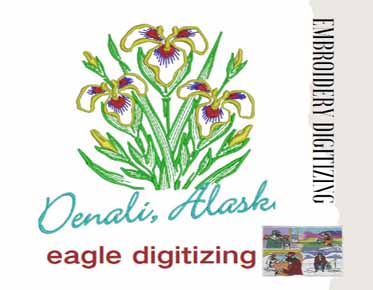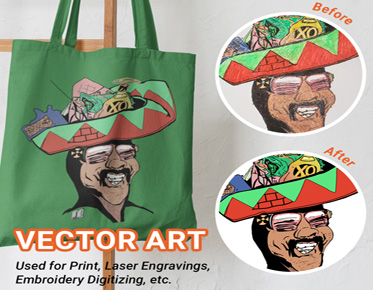Visual Vanguard: The Impact of Vector Graphics and Digitization on Social Media Marketing
In today's digital age, the fusion of vector graphics and digitization has revolutionized the landscape of social media marketing, offering marketers powerful tools to engage audiences, convey brand messages, and drive conversions. This article explores the intersection of vector graphics and digitization in social media marketing, delving into their definitions, applications, and future trends.
Understanding
Vector Graphics for Social Media
Vector graphics, characterized by their use of mathematical equations to create scalable images, are pivotal in social media marketing for their crispness, clarity, and adaptability across various platforms. These graphics ensure that visual content remains sharp and vibrant, even when resized or zoomed in, enhancing the overall aesthetic appeal of social media posts. In an era where attention spans are fleeting, high-quality visuals are paramount in capturing audience attention amidst the digital noise of social media feeds.
The Role of
Digitization in Social Media Marketing
Digitization has reshaped marketing strategies, offering unprecedented opportunities for brands to connect with consumers in meaningful ways. In the realm of social media marketing, digitization trends such as data-driven targeting, augmented reality filters, and interactive content have become game-changers, enabling marketers to deliver personalized experiences and drive engagement. The integration of vector graphics into digitized marketing campaigns further amplifies their impact, providing brands with visually stunning assets that resonate with their target audience.
Creating
Engaging Social Media Content with Vector
Graphics
Designing captivating social media graphics requires a deep understanding of design principles and audience preferences. By leveraging vector graphics, marketers can craft visually striking content that stands out in users' feeds. From eye-catching illustrations to sleek iconography, vector graphics offer endless possibilities for creating memorable social media posts that drive engagement and inspire action. Successful brands understand the importance of visual storytelling, using vector graphics to convey brand narratives and evoke emotions effectively.
Optimizing
Vector Graphics for
Different Social Media Platforms
Each social media platform has its own set of image size and format requirements, necessitating careful optimization of vector graphics for maximum impact. Whether it's Facebook's cover photo dimensions, Instagram's square aspect ratio, or Twitter's header specifications, marketers must tailor their vector graphics to fit seamlessly into the visual framework of each platform. Additionally, utilizing vector graphics for profile pictures, cover photos, and stories helps maintain brand consistency and enhances overall aesthetic appeal across social media channels.
Enhancing Brand Identity with Vector Graphics on Social Media
Consistency is key to building a strong brand identity on social media, and vector graphics play a crucial role in maintaining visual cohesion across all brand touchpoints. By incorporating branded templates, color schemes, and design elements into vector graphics, marketers can reinforce brand recognition and establish a cohesive visual identity that resonates with their audience. Case studies of brands with strong visual identities on social media underscore the importance of leveraging vector graphics to create a lasting impression and foster brand loyalty.
Utilizing Vector
Graphics for Social Media
Advertising
In the competitive landscape of social media advertising, vector graphics offer a distinct advantage in capturing audience attention and driving conversions. Whether it's designing eye-catching display ads or crafting engaging sponsored content, marketers can harness the power of vector illustrations to create compelling advertisements that stand out in users' feeds. A/B testing different variations of vector graphics allows marketers to identify the most effective ad creatives and optimize campaign performance for maximum ROI.
Vector Graphics
and Video Content in Social Media Marketing
The rise of video content on social media platforms has opened up new opportunities for incorporating vector graphics into marketing strategies. Marketers can use vector graphics to enhance video content with animated overlays, dynamic transitions, and informative visualizations that captivate viewers' attention and convey complex information in a digestible format. With the right tools and software, creating vector-based video assets has never been easier, empowering marketers to produce high-quality video content that resonates with their audience.
Harnessing the
Power of Infographics in Social Media Marketing
Infographics are powerful storytelling tools that combine data visualization with compelling narratives to communicate information effectively. By designing informative infographics with vector graphics, marketers can distill complex concepts, statistics, and trends into visually engaging content that is highly shareable on social media. Tips for creating shareable infographics include focusing on a single, compelling idea, using vibrant colors and typography, and incorporating eye-catching illustrations that enhance understanding and retention.
Maximizing
Engagement with Vector Graphics
in Social Media
Beyond aesthetics, vector graphics serve as powerful vehicles for storytelling and audience engagement on social media. Marketers can use vector graphics to craft narratives, evoke emotions, and encourage user interaction, fostering meaningful connections with their audience. Monitoring and analyzing engagement metrics for vector graphics posts provides valuable insights into audience preferences and content performance, allowing marketers to iterate and improve their social media strategies based on data-driven insights.
Influencer
Marketing with Vector
Graphics
Collaborating with influencers offers brands a unique opportunity to leverage their reach and credibility to amplify their message on social media. By providing influencers with branded vector graphics assets, marketers can ensure consistency in visual branding and messaging across influencer-driven campaigns. Measuring the impact of influencer-driven vector graphics posts allows marketers to gauge the effectiveness of their influencer partnerships and optimize future collaborations for maximum ROI.
Utilizing Vector
Graphics for Social
Media Contests and Giveaways
Contests and giveaways are effective tactics for driving engagement and expanding reach on social media. Designing eye-catching graphics for contest promotions and giveaway announcements can enhance participation and generate excitement among followers. By incorporating vector graphics into contest visuals, marketers can convey key details, such as entry requirements and prize information, in a visually appealing and attention-grabbing manner. Ensuring compliance and fairness in vector graphics contests is essential to maintain transparency and uphold the integrity of the promotion.
The Role of
Vector Graphics in Social Media Storytelling
Storytelling is a powerful tool for building emotional connections and fostering brand loyalty on social media. Vector graphics play a vital role in visual storytelling, enabling marketers to craft compelling narratives that resonate with their audience. By combining engaging visuals with captivating copy, brands can create immersive storytelling campaigns that captivate attention and drive engagement. Examples of brands excelling in social media storytelling with vector graphics demonstrate the effectiveness of this approach in building brand affinity and driving conversions.
Accessibility and
Inclusivity in Social Media Marketing with Vector Graphics
Designing accessible graphics is essential to ensure that all users, including those with disabilities, can engage with social media content effectively. Vector graphics offer flexibility in creating accessible designs that cater to diverse audiences. By following accessibility guidelines and utilizing tools for checking accessibility, marketers can ensure that their vector graphics are inclusive and compliant with accessibility standards. Incorporating alt text, descriptive captions, and color-contrast considerations in vector graphics content enhances accessibility and ensures that all users can access and enjoy social media content regardless of their abilities.
Measuring
ROI and Effectiveness of Vector Graphics
in Social Media Marketing
Measuring the return on investment (ROI) and effectiveness of vector graphics in social media marketing is crucial for optimizing strategies and maximizing results. Key metrics for evaluating the performance of vector graphics posts include engagement metrics such as likes, shares, and comments, as well as conversion rates and click-through rates. By analyzing data insights, marketers can identify trends, understand audience preferences, and refine their vector graphics strategies to drive better outcomes. Iterating and improving vector graphics strategies based on data-driven insights is essential for staying competitive and achieving long-term success in social media marketing.
Future
Trends and Innovations in Vector Graphics
and Social Media Marketing
The future of vector graphics and social media marketing holds exciting possibilities, driven by advancements in technology and evolving consumer behaviors. Predicted developments in vector graphics technology for social media include enhanced interactivity, augmented reality integration, and personalized content experiences. Emerging trends in social media marketing utilizing vector graphics include the rise of ephemeral content, interactive storytelling formats, and immersive brand experiences. By preparing for the future of vector graphics in social media marketing, marketers can stay ahead of the curve and leverage new opportunities to engage audiences and drive business results.
Conclusion
In conclusion,
vector graphics and digitization have become indispensable tools for marketers
seeking to elevate their social media marketing strategies. From creating
engaging content and enhancing brand identity to driving conversions and
fostering engagement, vector graphics play a pivotal role in capturing audience
attention and conveying brand messages effectively. As social media evolves,
brands that want to keep a competitive edge and flourish in the ever-changing
field of social media marketing will need to embrace vector graphics and remain
on top of evolving trends and developments. By embracing continuous innovation
and adaptation, marketers can harness the full potential of vector graphics to
enhance their social media presence and achieve their marketing objectives.
Eagle Digitizing offers professional vector artwork services to ensure your graphics are of the highest
quality and ready to make an impact.



